Vacuum Grease and Vacuum Epoxy
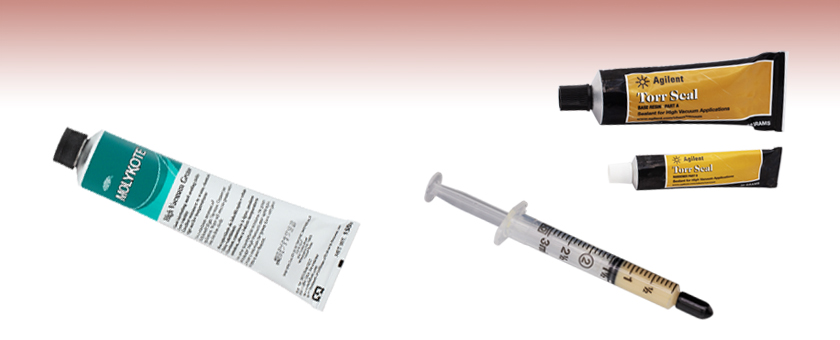
- Vacuum-Compatible Grease to 10-9 Torr
- Vacuum Epoxy Seals Leaks Down to 10-9 Torr
- Excellent for Vacuum and Non-Vacuum Applications
SG10
Silicone Vacuum Grease
TS10
Vacuum Epoxy
GKZ8
Apiezon Grease

Please Wait
Vacuum Epoxy
Thorlabs' Vacuum Epoxy can be used to seal leaks in vacuum equipment down to 10-9 Torr. This line of epoxy can form a high-strength, long-term bond with metals, ceramics, or glass and does not require solvent to evaporate. Please note that epoxy resins are prone to solidification or crystallization. If this occurs, the product can easily be returned to a liquid state by immersing the tube in warm [approximately 100 °F (38 °C)] water for 30 minutes. Ensure all material is melted prior to use. Allow the resin component to return to room temperature prior to mixing with the hardener.
High-Temperature and Low CTE Epoxy
This two part, 100% solid, heat curing epoxy can be used in applications requiring constant performance at temperatures up to 250 °C. It can handle 250 °C to 350 °C for brief periods. The epoxy is vacuum compatible and passes NASA low outgassing standard ASTM E595.
Silicone Vacuum Grease
Silicone grease, a general laboratory lubricant, works over a higher temperature range (-40 °C to 260 °C) than hydrocarbon greases. Silicone grease can be used for both vacuum and non-vacuum applications, such as lubricating rubber gaskets, glass-to-rubber boundaries, and water-treating equipment.
Apiezon Grease
For higher vacuum requirements, Thorlabs offers apiezon grease, which contains PTFE for higher lubricity and has an optimal working range of 10 °C to 30 °C. Apiezon grease is recommended for both general applications and vacuum applications down to 10-9 Torr. This grease comes in a syringe for easy use and is ideal for re-lubricating the leadscrew threads of our Z9, ZFS, and ZST actuators.
| Posted Comments: | |
David McMullin
(posted 2024-01-22 12:17:21.07) Hello,
I am wondering if I can use either of your vacuum greases within a sealed optics tube assembly? Do I have to worry about migration or off-gassing contaminating lens surfaces?
Thanks very much,
Dave jdelia
(posted 2024-02-22 01:38:33.0) Thank you for contacting Thorlabs. We have reached out to you directly to discuss your application. user
(posted 2023-06-03 02:47:58.743) We have used TS10 in our UHV chamber. Can you tell us upto what temp. this epoxy will sustain if we bake our chamber? cdolbashian
(posted 2023-06-12 08:21:50.0) Thank you for reaching out to us with this inquiry. The upper limit of the operating temperature of this epoxy is 120°C. The entire data sheet can be found with the rest of our supporting documentation by clicking the red "docs" icon to the left of each product number below. marlinne
(posted 2017-09-27 23:01:41.65) I am looking to bond silicon rubber and titanium and use this in a high temperature (~300C), high vacuum (~1E-7 torr) environment. Would this product be recommended for this application? Thanks for your help. tfrisch
(posted 2017-11-14 10:25:26.0) Hello, thank you for contacting Thorlabs. 353NDPK can handle 300 °C to 400 °C for brief periods. Furthermore, we do use this epoxy in some of our Polaris series mounts which can be used down to 10^-9 torr. I will reach out to you about the duration that you need to meet that higher temperature range. ckompell
(posted 2016-08-30 15:32:43.41) Hello, I would like to know if this material has any water content. I am interested in using it to seal materials that are extremely reactive to H2O. Also does this material outgas O2? Thanks, Chris. tfrisch
(posted 2016-09-01 01:27:28.0) Hello, thank you for contacting Thorlabs. I will reach out to you with our Material Safety Data Sheet and Spec Sheet for TS10. foued.amrani
(posted 2016-07-08 09:35:48.26) Bonjour,
Je voulais savoir si votre colle TS10 ne dégaze pas sous vide ainsi pollué l’intérieur du milieu sous vide.
Merci par avance.
Bien cordialement. joseangel.garcia
(posted 2015-09-23 11:42:42.59) Dear Srs
We would like to buy one item of your product TS10 vacuum epoxy. If you can give us an account we will transfer the cost including p&p to:
Departamento de Física Aplicada II
Universidad del Pais Vasco
Campus de Leioa
48940 Bizkaia, Spain
and afterwards you can send it to the above address.
Best regards
Jose A. García shallwig
(posted 2015-09-24 02:07:27.0) This is a response from Stefan at Thorlabs. Thank you very much for your interest in our products. We will contact you directly and send you a quote for the TS10. slavov_d_g
(posted 2015-08-17 08:42:28.753) Dear Sir/Madam,
I have a question. My glued fused silica component have to withstand high-vacuum (10^-7 to 10^-8 oC) working continuously at temperatures between 150 0C and 200 oC. Is it Thorseal adhesive (TS10) OK or I have to use 353NDPK?
Best regards
Dimitar Slavov
Institute of Electronics,
Bulgarian Academy of Sciences besembeson
(posted 2015-09-29 05:22:04.0) Response from Bweh at Thorlabs USA: I would recommend the 353NDPK. When using this in high vacuum environments, I would advise you use the recommended cure schedule of 150 deg for one hour for best results. mvuotila
(posted 2013-08-08 06:33:23.38) WE are looking for a Vacuum epoxy which can be used short period of times up to 280 °C / 560 °F (reflow of SMD parts).
Can TS10 take this heat?
Matti Vuotila
R&D Manager, Mirion Technologie (RADOS) Oy, Finland jlow
(posted 2013-08-08 16:06:00.0) Response from Jeremy at Thorlabs: The flash point of the TS10 is quite a bit lower than your requirement and therefore not appropriate for your application. |

- Seals Leaks in Vacuum Equipment Down to 10-9 Torr
- Forms a Reliable, High Strength, Long-Term Bond with Metals, Ceramics, or Glass
- No Solvent Necessary to Evaporate
- At Room Temperature: Hardens in 3 to 4 Hours, Cures in 72 Hours
- Cures in 2 Hours at 60 °C, in 1 Hour at 82 °C, or in 20 to 30 Minutes at 121 °C
- Mixing Ratio (by Volume): 2.5 Parts Resin to 1 Part Hardener
- 82 g (2.9 oz) Base Resin, 36 g (1.3 oz) Hardener
Please note that epoxy resins are prone to solidification or crystallization. If this occurs, the product can easily be returned to a liquid state by immersing the tube in warm [approximately 100 °F (38 °C)] water for 30 minutes. Ensure all material is melted prior to use. Allow the resin component to return to room temperature prior to mixing with the hardener.
This epoxy resin is classified as a dangerous good in some countries. Depending on the delivery location, this item may need to be shipped separately from the rest of your order at an additional charge. Please contact our sales department if there are questions or concerns when placing an order for this item.

- Excellent Wicking for Fiber Optic Applications
- High Temperature Epoxy - Can Perform at Constant 250 °C
- Passes NASA Low Outgassing Standard ASTM E595 with Proper Cure
- Color Changes Upon Curing From Amber to Dark Red
- Pot Life ≤3 Hours
- Pre-Measured, 4 g Packs
EPO-TEK 353ND is known industry wide as a high temperature epoxy. This two part, 100% solid, heat curing epoxy can be used in applications requiring constant performance at temperatures up to 250 °C. It can handle 250 °C to 350 °C for brief periods. The epoxy is vacuum compatible and passes NASA low outgassing standard ASTM E595. Thorlabs offers 353ND epoxy in pre-measured, 4-gram packs that provide repeatable performance and eliminate the need for measuring.
Dangerous Goods
Please note that 353NDPK is classified as a dangerous good in some countries. Depending on the delivery location, this item may need to be shipped separately from the rest of your order (and possibly with a different carrier) at an additional charge. This 2-part epoxy is stocked within the USA and Germany. Please contact our sales department if there are questions or concerns when placing an order.
Shelf Life
353NDPK Epoxy has a shelf life of 365 days when stored at 23 °C. This time frame begins on the date the epoxy was packaged at the manufacturer. Upon receipt by the end user, Thorlabs guarantees that the remaining shelf life will be at least 3 months.

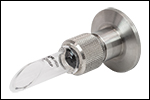
Click to Enlarge
Vacuum grease is applied to the O-ring of our KF25C050 Vacuum Flange to Compression Fitting Adapter, which can be used to integrate our Optical Ports into a vacuum system.
- Higher Temperature Range (-40 °C to 260 °C) than Hydrocarbon Greases
- Recommended for 1x10-5 to 1x10-6 Torr Vacuums
- Resistant to Most Chemicals
- 150 g (5.3 oz)
This silicone grease is very popular as a general laboratory lubricant and is commonly used as a stopcock grease, to lubricate synthetic or silicone rubber gaskets, or at glass-to-rubber boundaries. However, it should not be used on fluorosilicone O-rings and gaskets. In addition, the lubricant can also be used for a wide array of non-vacuum applications such as the lubrication of water-treating equipment, general laboratory equipment, or O-rings for binoculars and telescopes.

- 1.5 cc Syringe of Apiezon 100 Grease
- Vacuum-Compatible Grease to 10-9 Torr
- Prolongs Actuator Lifetime
- Ready to Dispense
This Apiezon grease, which is ideal for re-lubricating the leadscrew threads of our Z9, ZFS, and ZST actuators, has excellent anti-seize properties. It contains PTFE for higher lubricity, is recommended for both general use and vacuum applications down to 10-9 Torr, and has an optimal working range of 10 °C to 30 °C (50 °F to 86 °F). The grease comes in a syringe for easy application.
Note: It is recommended that the lead screw and end ball of the Z9, ZFS, and ZST actuators are lubricated every 10,000 cycles or whenever a squeaking noise is heard during motion.
 Products Home
Products Home










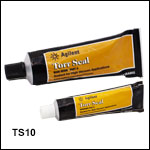
 Zoom
Zoom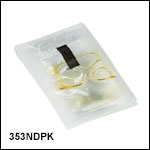
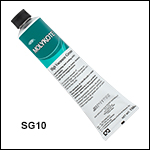
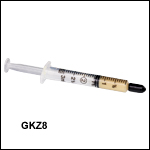
 Vacuum Grease & Epoxy
Vacuum Grease & Epoxy